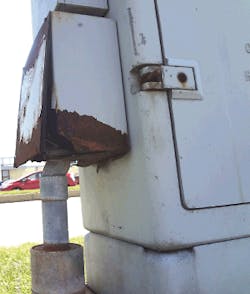Can you identify the Code violation(s) in this photo?
Hint: Traffic lights still working?
Find the Answer
How well do you know the Code? Think you can spot violations the original installer either ignored or couldn’t identify? Here’s your chance to moonlight as an electrical inspector and second-guess someone else’s work from the safety of your living room or office. Can you identify the Code violation(s) in this photo?
‘Tell Them What They’ve Won...’
Using the 2011 NEC, correctly identify the Code sections that show violation(s) in this month’s photo — in 200 words or less — and you could win something to put in your toolbox. E-mail your response to [email protected], and we’ll select three winners (excluding manufacturers and prior winners) at random from the correct submissions. Winners will receive a set of insulated hand tools from Ideal Industries, Inc., valued at more than $125.* The set includes 9.25-in. insulated side-cutting pliers, 10-in. insulated tongue-and-groove pliers, and a 0.25-in. 3 6-in. insulated screwdriver. (* Please allow six to eight weeks for delivery of tools.)
OCTOBER WINNERS
We had three winners this month: Michael A. Patti, IBEW technician, Massapequa Park, N.Y.; Alan Burczyk, project manager, Barbaro Electric Co., Inc., Hackensack, N.J.; and Bud Reichard, P.E., owner, AES Associates, Seattle. They were all unimpressed with the mounting configuration of this outdoor luminaire.
As noted in 410.10(A), “luminaires installed in wet or damp locations shall be installed such that water cannot enter or accumulate in wiring compartments, lampholders, or other electrical parts.” This fixture was mounted so low to the ground that it could only be arranged to face upward. There’s no way that water could be kept from entering the socket. The other item to make note of is the type of lamp that has been installed in this fixture, which appears to be an indoor-rated bulb, not an outdoor-rated lamp.
Although you can’t see it in the photo, the fixture had this sentence stamped on it: “Wet location when lampholder is aimed below horizontal.”
About the Author
Joe Tedesco
Tedesco served the industry in many roles during his career. He was a director, senior electrical code instructor for National Technology Transfer, Inc. and American Trainco, Inc.. He was also a codes, standards and seminar specialist for the International Association of Electrical Inspectors and an electrical field service specialist for the National Fire Protection Association in Quincy, Mass. He ran his own business as an NEC consultant and is a Massachusetts licensed master electrician and journeyman electrician and certified electrical inspector (one and two family 2A; General 2B, and Plan Review, 2C). Tedesco also wrote articles for CEE News and EC&M (Code Violations Illustrated and What's Wrong Here?) for more than 15 years and helped launched the Moving Violations video series.
